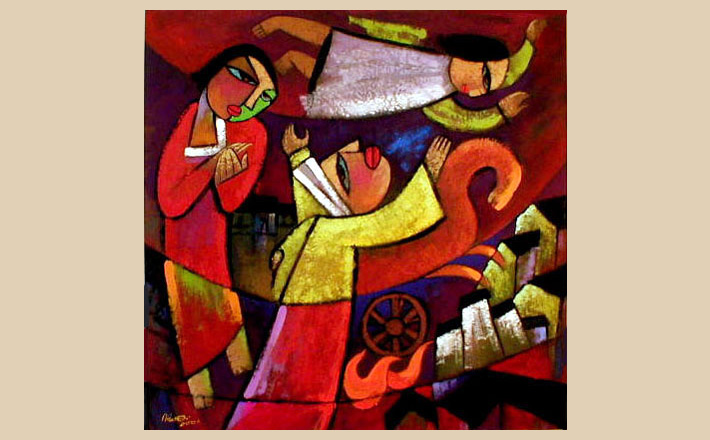Commentary on Luke 9:51-62
The Lukan travel narrative (chapters 9-19) begins with a notice of Jesus’ resolve to go to Jerusalem and his inhospitable reception by a Samaritan village.
Luke sets the stage: “Now it happened that as the time was drawing near for him to be taken up, he firmly resolved to go to Jerusalem” (Luke 9:51). The notice that “the time was drawing near” (literally, “as the days were being fulfilled”) elsewhere in Luke/Acts suggests a fulfillment of prophecy (compare with the phrase in Acts 2:1 indicating that Pentecost is fulfilling Jesus’ prediction in Luke 24:49) and sets the journey within the divine plan. But what is drawing near? Luke indicates that it is the time for Jesus “to be taken up” (analempseos). Certainly this term parallels the discussion of Jesus’ departure (exodos), which Jesus, Moses, and Elijah had discussed at the transfiguration (9:31). The departure encompasses the events, including his passion, leading up to his final departure from the disciples. Jesus is “firmly resolved to go to Jersualem” where these events will be fulfilled. The Greek is literally “he set his face” (autos to prosopon esterisen) and reflects a Hebraism1 that suggests a “fixedness of purpose.”2
The journey to Jerusalem has a less than auspicious beginning. Luke narrates: “He sent messengers ahead of him, and they went and entered a Samaritan village to prepare for him. But the people there did not welcome him, because he was set on going to Jerusalem” (Luke 9:52-53). Given the animosity between Jews and Samaritans (see 10:25-37), it is not surprising that the Samaritans refuse to show hospitality to the traveling prophet, Jesus, and his followers. The disciples, James and John, offer an immediate remedy that they believe has scriptural warrant: “Lord, do you want us to tell fire to come down from heaven and wipe them out?” (Luke 9:53). They are perhaps echoing Elijah’s summoning heavenly fire to consume some soldiers (2 Kings 1:9-12), as surmised by some scribes who added “as Elijah did” at the end of v. 54. Jesus’ response is no less decisive: “But he turned and rebuked them. Then they went to another village”3 (Luke 9:55-56). Jesus’ rebuke of the disciples’ proposed violence resonates with other Second Temple Jewish texts, which likewise offer critiques of those passages that depict prophets and even Abraham as calling for the destruction of “sinners.”4 The judgment on the disciples’ prejudice against these Samaritans will come into sharper focus very soon when Jesus tells the parable of a “good” Samaritan who is held up as the model of hospitality and philanthropy (compare with Luke 10:25-37; also 17:11-19).
What follows is a series of three chreiae. A chreia is “a brief saying or action making a point, attributed to some specified person.”5 These are “apocritic chreiae”6 which are embedded chreiae spoken in response to another’s statement. The first two chreiae are familiar to the authorial audience, which recognizes them from other versions (Matthew 8:18-22/ Q 9:57-60): “As they were going along the road, someone said to him, ‘I will follow you wherever you go!’ And Jesus said to him, ‘Foxes have dens and birds of the sky have nests, but the Son of Man does not have a place where he can lay his head.’ Then he said to another, ‘Follow me.’ But he replied, ‘[Lord,] first allow me to go bury my father.’ Then he said to him, ‘Let the dead bury their own dead; but you, when you have left, proclaim the kingdom of God’ (Luke 9:57-60). In Luke’s version, by eliminating the reference to Jesus as “Teacher” (Matthew 8:18), the statements that elicit the chreia begin with a form of akoloutheo (“I will follow”; “follow me”), which introduces the theme of discipleship. To follow Jesus, the “Son of Man” who — unlike “foxes” and “birds of the sky” — has no place to lay his head, is to embark on a journey that may involve alienation; indeed it already has in the preceding rejection by a Samaritan village (Luke 9:51-56)! Further, the call to follow Jesus on the journey of “proclaiming the kingdom of God” is a call to radical commitment, whether the dead who are left to bury the dead are understood literally as referring to those who deal with corpses (e.g., grave diggers) or metaphorically as referring to those who are spiritually dead and who refuse to take up this challenge. In this regard, the call to follow Jesus is a call to participate in a “prophetic drama” that, like Jeremiah’s or Ezekiel’s refusal to mourn the dead, underscores the crisis at hand (compare with Jeremiah 16:5-9; Ezekiel 24:16-24).
The third statement, a responsive chreia, is unique to Luke. Notice first that this third would-be disciple combines elements from the first two: “I will follow you (compare with v. 57) Lord, but first allow me (compare with v. 59) to say goodbye to those in my household” (Luke 9:61). Missing in this excuse is any sense of urgency (“I will follow you anywhere!”; “let me first bury my father”); rather the request is simply to return home to say good-bye to family (as Elijah did; compare with 1 Kings 19:19-21). Jesus’ response functions to provide a rationale for why the would-be disciple must leave the dead and cannot return to his family: “But Jesus said to him, ‘Nobody who has put his hand to the plow and looks back is fit for the kingdom of God’” (9:62). Luke has elaborated the chreiae, “let the dead bury the dead” and “(you) preach the kingdom” into the form of an enthymeme7, by adding one of the missing premises. The logic of the Lukan Jesus can be reconstructed as follows:
First premise: No one who puts his hand to the plow and looks back is fit for the kingdom of God
(Missing) Second premise: You wish to be fit for the kingdom of God
Conclusion: Therefore, leave the dead to bury the dead, and go, proclaim the kingdom of God.
Furthermore, the new chreia is a gnomic saying in form8 that is, it attributes to Jesus a saying that would have been rather well-known in the ancient Mediterranean world. For example, in Hesiod’s Works and Days, a plowman is described as one “who attends to his work and drives a straight furrow and no longer gapes after his comrades, but keeps his mind on his work.”9 In other words, to look back from the plow (whether to family living or dead) was to risk cutting a crooked or shallow furrow and thus ruining the work altogether! There is no place for looking back or even trying to look in two directions at once (being “two-faced”); rather, would-be disciples must be single-minded in purpose, setting their faces like Jesus on the task at hand.
Material adapted from Luke. Paideia Commentary Series. Eds. Mikeal C. Parsons, Charles H. Talbert, and Bruce. Longenecker. Grand Rapids: Baker Academic (a division of Baker Publishing Group), 2015. Used by permission.
Notes:
1 compare with Ezekiel 21:2; Evans 1987, 80-84.
2 Plummer 1896, 263.
3 for a similar rebuke of a disciple’s violence [both proposed and actual], see Acts of Philip 26-27.
4 compare with e.g. Testament of Abraham 10.
5 Theon, Progymnasmata 96.
6 compare with Theon, Progymnasmata 98.
7 a syllogism with a missing premise; compare with Theon, Progymnasmata 99.
8 Theon, Progymnasmata 99.
9 1.443; compare with Pliny, Naturalis Historia 18.19.49.


June 26, 2016